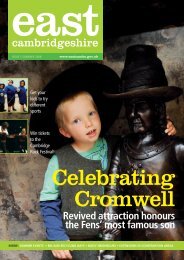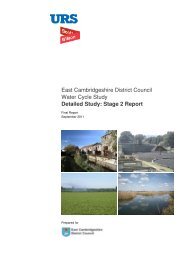6. Soham Conservation Area - East Cambridgeshire District Council
6. Soham Conservation Area - East Cambridgeshire District Council
6. Soham Conservation Area - East Cambridgeshire District Council
You also want an ePaper? Increase the reach of your titles
YUMPU automatically turns print PDFs into web optimized ePapers that Google loves.
<strong>6.</strong>1 <strong>Soham</strong> (‘lakeside settlement’) developed on the edge of <strong>Soham</strong> Mere,<br />
a large inland sea. It was a relatively substantial settlement by the 11 th<br />
century centred on a Minster Church reputedly founded by St Felix in<br />
the 7 th century and where his remains were buried before they were<br />
removed to Ramsey in 102<strong>6.</strong> The abbey was destroyed in a Viking raid<br />
in the 9 th century, but was not rebuilt. In the 10 th century, Luttingus a<br />
Saxon nobleman reputedly built a Cathedral and Palace on the site of<br />
the present day church and adjacent land. Traces of the Saxon<br />
Cathedral are said to still exist within the fabric of St Andrew’s Church<br />
and the Bishops Palace existed as a picturesque ruin until the mid 19 th<br />
century.<br />
<strong>6.</strong>2 The ‘new’ Church of St Andrew has its origins in the 12 th century and<br />
was altered and expanded in the 13 th , 14 th and 15 th centuries. The<br />
church of <strong>Soham</strong> belonged to the royal demesne manor throughout the<br />
12 th century until Richard I in 1189 gave the parish church in free alms<br />
to the Poitevin Cisterian Abbey of Le Pin (Vienne). In 1285, however,<br />
Le Pin arranged to cede its <strong>Soham</strong> estate to its fellow Cisterian Abbey<br />
of Rewley who in turn ceded possession in 1451 to Pembroke College,<br />
Cambridge with whom it still rests.<br />
<strong>6.</strong>3 In the late Saxon period <strong>Soham</strong>’s wealthy royal manor was the main<br />
manor of the village. It is probable that at this time the settlement was<br />
linear along Pratt Street/High Street, thus creating an outline of the<br />
modern town. By 1086, <strong>Soham</strong> comprised three manors, the main one<br />
belonging to the king, a smaller one belonging to Ely and a third in<br />
secular ownership. Before 1066 the royal manor had been part of King<br />
Edward’s ancient demesne, and in 1086 was still possessed by King<br />
William. It remained with succeeding kings until the late 12 th century.<br />
<strong>6.</strong>4 The medieval village of <strong>Soham</strong> expanded the linear Saxon village,<br />
stretching from north to south amid extensive closes and crofts along a<br />
long street, which from the 12 th century formed part of a route from<br />
Fordham to Ely. In the 1650s, the moist densely inhabited part of the<br />
village was Churchgate Street.<br />
<strong>6.</strong>5 The River Snail was partially canalised in the medieval period and the<br />
mere side became a focus for activity; its importance as a source of<br />
natural resources reflected in the growth of settlement along its shores.<br />
<strong>Soham</strong> appears to have been a wealthy town in the medieval period<br />
that saw it flourish as a centre of trade with the establishment of an<br />
island port. The manor of the rectory alone was of sufficient worth to be<br />
granted to overseas lords and for them to take an interest in it.<br />
<strong>6.</strong>6 Where the River Snail entered the mere, a mill complex arose (milling<br />
is recorded in the Doomsday Book). A survey undertaken in 1656<br />
demonstrated that the area around Mill Corner was intensively settled,<br />
but the main areas of activity were the High Street and Pratt Street<br />
along with Paddock Street; the area around Clay Street was another<br />
6






